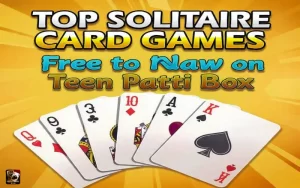Teen Patti, also known as Indian Poker, is a popular card game that has captivated players across India and beyond. With its blend of strategy, Teen Patti Box skill, and luck, Teen Patti offers an exciting gaming experience that can be enjoyed by players of all ages. Whether you’re a seasoned player or a newcomer, understanding the essential rules of Teen Patti is crucial for a successful game. In this article, we will explore the five essential Teen Patti rules every player should know to enhance their gameplay and increase their chances of winning.
1. Understanding the Basics of Teen Patti
Before diving into the specific rules, it’s important to grasp the basic structure of Teen Patti. The game is typically played with a standard 52-card deck and can accommodate 3 to 6 players. The objective is to have the best three-card hand and win the pot, which is the total amount of money bet by players during the game.
The Hand Rankings
In Teen Patti, the strength of your hand is determined by the following rankings, from highest to lowest:
- Trail (Three of a Kind): Three cards of the same rank.
- Pure Sequence (Straight Flush): Three consecutive cards of the same suit.
- Sequence (Straight): Three consecutive cards of different suits.
- Color (Flush): Three cards of the same suit, not in sequence.
- Pair: Two cards of the same rank.
- High Card: If no one has a better hand, the player with the highest card wins.
Understanding these hand rankings is crucial, as they will guide your betting strategy and decision-making throughout the game.
2. The Betting Structure
Teen Patti involves a unique betting structure that adds excitement and strategy to the game. Here are the key aspects of the betting process:
Ante Bet
At the beginning of each round, all players must place an initial bet known as the ante. This creates the pot that players will compete for. The ante amount is usually predetermined and can vary depending on the stakes of the game.
Betting Rounds
After the ante is placed, players take turns to either call, raise, or fold. Here’s what each term means:
- Call: Matching the current bet to stay in the game.
- Raise: Increasing the current bet, which forces other players to either match the new bet or fold.
- Fold: Discarding your hand and exiting the round, forfeiting any money already bet.
Players can continue to raise the stakes until all but one player has folded, or until a showdown occurs where players reveal their hands.
Showdown
If multiple players remain after the final betting round, a showdown occurs. Players reveal their hands, and the player with the highest-ranking hand wins the pot. If a player has raised the bet and all others have folded, that player wins the pot without needing to show their cards.
3. The Importance of Bluffing
Bluffing is a critical aspect of Teen Patti that can significantly impact your success in the game. It involves deceiving your opponents into believing you have a stronger hand than you actually do. Here are some tips for effective bluffing:
Timing is Key
Bluffing is most effective when used sparingly. If you bluff too often, your opponents may catch on and call your bets more frequently. Choose your moments wisely, especially when the pot is large or when you sense weakness in your opponents.
Read Your Opponents
Pay attention to your opponents’ betting patterns and body language. If they seem hesitant or uncertain, it may be an opportune time to bluff. Conversely, if they are confident and aggressive, it may be best to play conservatively.
Mix Up Your Play
To keep your opponents guessing, vary your gameplay. Sometimes play aggressively with strong hands, and other times, play passively with weaker hands. This unpredictability makes it harder for opponents to read your intentions.

4. The Role of Position
In Teen Patti, your position at the table can significantly influence your strategy and decision-making. The order in which players act can affect the flow of the game and the information available to each player. Here’s how position plays a role:
Early Position
Players who act early in the betting round have less information about their opponents’ hands. As a result, they should play more conservatively and only bet on strong hands. Being in an early position means you’ll need to be cautious, as you have less insight into how others will play.
Late Position
Players in a late position have the advantage of observing their opponents’ actions before making their own decisions. This allows for more strategic betting, as you can gauge the strength of your opponents’ hands. In a late position, you can afford to be more aggressive, especially if you have a decent hand.
Middle Position
Players in the middle position have a balanced view of the game. They can assess the actions of both early and late players, allowing for a more informed decision-making process. In this position, you can mix up your strategy based on the betting behavior of those around you.
5. Etiquette and Sportsmanship
Understanding the etiquette and sportsmanship involved in Teen Patti is essential for maintaining a positive gaming environment. Here are some key points to keep in mind:
Respect Your Opponents
Always treat your fellow players with respect, regardless of the outcome of the game. Avoid making negative comments or engaging in unsportsmanlike behavior. A friendly atmosphere enhances the enjoyment of the game for everyone involved.
Follow the Rules
Adhering to the established rules of Teen Patti is crucial for fair play. If you’re unsure about a specific rule, don’t hesitate to ask for clarification. Familiarizing yourself with the rules not only improves your gameplay but also shows respect for your fellow players.
Manage Your Emotions
Card games can be intense, and emotions can run high. It’s important to manage your emotions and maintain composure, whether you’re winning or losing. Avoid displaying frustration or anger, as this can disrupt the game and create a negative atmosphere.
Practice Good Bankroll Management
Responsible bankroll management is essential for a sustainable gaming experience. Set limits on how much you’re willing to bet and stick to them. Avoid chasing losses, and know when to walk away from the table. This discipline will help you enjoy the game without financial stress.
Conclusion
Teen Patti is a thrilling card game that combines strategy, skill, and social interaction. By understanding these five essential rules—hand rankings, betting structure, bluffing, position, and etiquette—you can enhance your gameplay and increase your chances of success. Whether you’re playing with friends at home or participating in a larger tournament, these rules will serve as a solid foundation for your Teen Patti experience. So gather your friends, shuffle the cards, and get ready to enjoy the excitement of Teen Patti!








